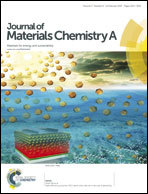Preparation and properties of a novel form-stable phase change material based on a gelator†
Abstract
A series of gelators (Gm, m is the length of the alkyl tails, m = 2, 4, 6, 8, 10, 12, 14, 16 and 18) containing 4,4′-diaminodiphenylmethane moieties were synthesized. The chemical structures of Gm were confirmed by 1H NMR and MS. The form-stable phase change materials (FSPCMs) were prepared by introducing Gm into paraffin. The minimum gelation concentration (MGC) and gel-to-sol transition temperature (TGS) properties were tested by the “tube-testing method”. It found that Gm (m = 2, 4, 6) was insoluble in paraffin, while the MGC and TGS of Gm (m = 8, 10, 12, 14, 16, 18) increased with the increase of alkyl chain. The structure and morphology of the PCMs were systematically investigated by FT-IR, POM, 1D WXAD and SEM. Experimental results revealed that paraffin was restricted because the gelators could self-assemble into three-dimensional netted structures, leading to form the shape-stable PCMs without leakage even above their melting point. The thermal properties were studied by DSC. The research showed that the G18/paraffin FSPCMs exhibited excellent thermal stability and high heat storage density. The shape stability of G18/paraffin was investigated by rheological measurements, indicating that solid ↔ hard gel ↔ soft gel ↔ liquid was observed with the increase of temperature. This work is useful in the comprehensive academic research and industrial application of PCMs.


 Please wait while we load your content...
Please wait while we load your content...